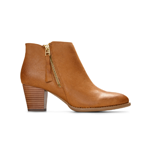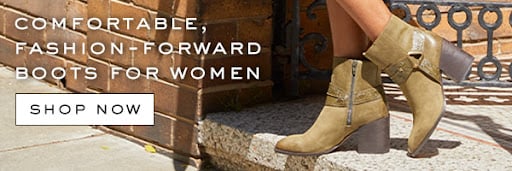
Breaking In Leather Boots: Tips & Techniques for a Perfect Fit

From rugged work boots to polished dress pairs, the charm of a good pair of leather boots is undeniable. It’s a timeless piece of footwear that perfectly blends fashion with function.
Ideally, a new pair of genuine leather boots should fit like a glove, contouring seamlessly to your foot, so much so that they feel like a second skin. But most boots won’t come from the box fitting perfectly. The supple leather needs to be molded to your foot. And that won’t happen overnight—it takes patience, time, and repeated wear for the leather’s natural toughness to be tamed, molded, and broken in.
But what’s the best way to break in leather boots, without subjecting yourself to long-time discomfort?
Here are the expert tips and techniques for how to break in leather boots.
The Foundation of Fit: How Proper Sizing Matters
Before we dive into tips and tricks for breaking in your leather boots, we must emphasize a boot-wearing prerequisite: before you take any other step, the boots must be correctly sized. If they aren’t the right size from the outset, no amount of breaking-in can mold them to your feet. So, how should boots fit?
As you begin testing boots by size, aim for a fit that’s snug but not suffocating, with enough room to wiggle your toes, but not so much that you slide around with each step. Remember, leather boots will mold to your foot’s shape over time. So, some discomfort is expected; however, outright pain is a clear sign that you have the wrong size.
Ready to try on leather boots and narrow down the optimal size for your feet?
Length isn’t the only consideration. You also need to factor in:
- Heel – A little slippage in the heel is fine—think a quarter inch of movement—but excessive slippage or tightness are indicators of improper sizing.
- Width – Too narrow of boots may squeeze your feet, causing pain or even long-term issues. Conversely, boots that are too wide will allow the foot to slide from side to side, which leads to instability. This is why finding the right fit is essential, not just for comfort but for foot health as well. If you’re looking for options that cater to wider calves without compromising on stability or style, check out our wide-calf boots for women.
- Flex point – Check for your boot’s flex point—where it bends when you step. The flex point should align with the natural flex of the foot, usually right at the base of your toe joints, around the ball of your foot. If it breaks in the wrong spot, it could cause foot pain and damage the boots.
- Arch – Most boots are relatively flat with precious little arch support. Despite this, you should consider your type of arch—flat, normal, or high—and how that will impact wear.
- Toe box – Ever wondered, how much room should you have in your toe box? With a toe box, the primary concern is to ensure that it’s not too small. A too-large toe box won’t have a major impact on the boot’s feel, especially after they’ve been broken in.
- Boot shaft – The shaft—the upper part of the boot that wraps around your leg—should fit comfortably around your ankle and calf. It shouldn’t be too tight or too loose, ensuring optimal comfort and aesthetics. Some leather boots, like Chelsea boots, tend to have fabric along the shaft for built-in stretch, which makes this style a bit more forgiving than zippered or other boots.
Also, keep in mind that boot sizing can vary greatly between different brands and styles. Always try on boots wearing the socks you plan to wear with them—in most cases, thicker socks for warmth during winter—and whenever possible, have your foot measured by a professional.
A Factor to Consider: Materials and Construction
Every boot has a backstory that’s written into the stitches and materials. The unique composition of each boot shapes its profile and ultimately influences how it will mold to the foot.
Are they full-grain leather or suede? The toughness of the leather affects break-in time.
Are the soles stitched or cemented? Goodyear Welt or Blake stitch? The boot’s construction influences flexibility and could inform your break-in strategy. Similarly, real leather boots will often take longer to break in than hybrid or synthetic materials.
Tips for How to Break in New Leather Boots
Let’s say you’ve found the perfect pair of leather boots. What now?
No matter the specific style of boot—from cowboy to Chelsea, from wingtip to work boots—breaking in leather will typically follow the same general framework.
#1 Plan Ahead
Do you have a hiking trip coming up? A bachelorette party in Nashville on the books?
When it comes to breaking in new leather boots, timing is key. Before you hit the trail or the town give yourself an ample allotment of time—at least a month—to properly break in the new leather boots. This allows your boots to gradually adjust to the shape and contours of your foot, ensuring a snug and comfortable fit.
The process of breaking in boots can be slow. The bulk of the process involves wearing and walking around in the boots for a bit each day, allowing them to slowly break in. It’s a repetitive process, but it’s necessary to avoid foot discomfort later on.
So, start well in advance of your trip or event—or boot season, in general—so you can focus on the experience, not your foot pain.
#2 Wear Boots Daily and Increase Duration Over Time
The simplest way to break in new leather boots is by, well, actually wearing them.
The process can start around the house for 10-30 minute intervals, gradually increasing wear time.
Early wear will give your feet a chance to adjust to the new boots while the material itself loosens up. Over time, you should start wearing them outside for short walks. And, once more, you can gradually increase the length and duration of these walks as your feet grow more accustomed to the boots.
When they start feeling better, you can try the boots in more real-world circumstances like a short hike or an evening out on the town.
#3 Wear Socks—Big Ones
As you start breaking your boots in, opt for a little extra protection with thick or padded socks.
Breaking in boots involves forming creases, increasing upper flexibility, and adapting the midsole to your arch. This will cause pressure, rubbing, and even discomfort on all parts of the foot, which is why some additional padding never hurts. Additionally, wearing thick socks can help stretch the leather out even more, which should fast-track the break-in process.
In the beginning, avoid cotton-based sports socks. They don’t usually provide enough cushion, nor are they thick enough. Instead, look for a thicker, softer wool sock.
#4 Add Moisturizers
Leather is chock-full of oils and tannins, which make it stiff and durable in its natural state.
While regular wear will break up the oils and eventually loosen up the leather, cobbler Rory Fortune notes in GQ that you can accelerate that process by rubbing the leather boots with leather-specific moisturizers:1
“Saphir cream really penetrates the leather, moistens it, conditions it, and softens it up. [I] also recommend saddle soap, which cleans the leather and helps it stay moisturized and conditioned without drying it out. You can also grab a shoe stretcher spray, which cobblers often use to stretch leather shoes to a larger size.”
How do you apply leather conditioner? Follow these simple steps for optimal leather boot care:
- Always read the specific instructions on the product label
- Apply a light layer of conditioner, but don’t go overboard
- Work the conditioner into the boots slowly and gently with a cloth or sponge
- Let the new boots sit so that the moisturizer can absorb into the leather fibers
- Wipe off any leftover oil or conditioner with a damp cloth
- Put your boots back on and continue breaking them in!
#5 Don’t Heat or Wet-Treat Them
A simple Google search on breaking in boots might lead you down a rabbit hole of questionable “quick-fix” methods—ones that sound appealing but can have damaging consequences.
You may stumble across advice suggesting you should apply direct heat to your boots using a blow dryer, steam them, or, in the most extreme cases, bake them in an oven. On the other end of the spectrum, you might read advice about drenching your boots in water to speed up the break-in process.
Let’s set the record straight: if you value your genuine leather boots, don’t try this at home. While these techniques might offer temporary stretch, they run a high risk of drying out the leather, potentially causing irreversible harm to the boot’s materials and structure, and leaving you with cracked leather shoes in a short while.
Preserving the integrity and quality of your leather boots should always take precedence over a rushed break-in process. Something about a tortoise and a hare, right?
Vionic: Leather Boots You Can’t Wait to Break In
No matter the type of boot, there are no quick hacks for breaking in real leather. Even after finding the perfect size boot, it will still take time, patience, and daily wear for even the most comfortable boots to contour to your feet.
Looking for your next pair?
At Vionic, we have a catalog of high-quality leather boots and footwear. Whether it’s the Evergreen Ankle Boot, or the Hazal Ankle Boot, our boots and booties are designed to blend comfort and style. Shop Vionic today and start breaking in your new favorite footwear tomorrow.
Sources:
- Ortiz, Gerald. “How to Break In Doc Martens (and Every Other Leather Shoe Giving You Blisters).” GQ. 15 March, 2023. https://www.gq.com/story/how-to-break-in-leather-shoes










